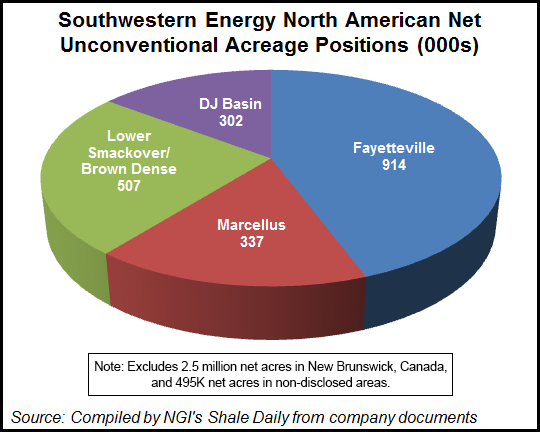Marcellus | E&P | NGI All News Access
Southwestern Tripled Marcellus Production in Second Quarter
Southwestern Energy Co. Marcellus Shale production during the second quarter was more than triple the year-ago level, and the company has been taking steps to get its gas out of the transportation capacity-constrained play. Meanwhile, production from its Fayetteville Shale activities edged up slightly.

“Our production growth of 17% during the quarter was strong, as our Fayetteville Shale gross production was more than 2 Bcf of gas per day during the quarter and our Marcellus Shale gross production reached 500 MMcf of gas per day in June,” said CEO Steve Mueller. “As a result, we have raised our production guidance for the remainder of the year and have increased our capital program due to our recent acquisition of additional acreage in the Marcellus Shale and for additional drilling in both areas.”
Gas and oil production totaled 160.1 Bcfe in the second quarter of 2013, up 17% from 137.4 Bcfe in the second quarter of 2012, and included 121.2 Bcf from the company’s Fayetteville Shale play, up from 121.0 Bcf in the second quarter of 2012. Production from the Marcellus Shale was 33.9 Bcf in the second quarter of 2013, compared to 9.9 Bcf in the second quarter of 2012.
At the end of the quarter Southwestern had 129 operated horizontal wells on production and 99 wells in progress in the Marcellus, resulting in net production of 33.9 Bcf in the second quarter, more than triple the 9.9 Bcf produced in the second quarter of 2012. Gross production from operated wells was 503 MMcf/d at the end of June. Southwestern said it expects to drill about 100 operated wells in the Marcellus Shale in 2013, compared to previous guidance of 86-88.
Southwestern has 337,000 net unconventional acres in the Marcellus, according to company documents. It has another 914,000 acres in the Fayetteville, 507,000 acres in the Lower Smackover/Brown Dense, and 302,000 acres in the Denver-Julesburg Basin.
“In the Marcellus, we’ve learned a lot about productivity in our wells in northern Susquehanna County. And our production ramp out of that area has been tremendous, growing from 0 to over 100 million-180 million a day in just seven months,” Mueller said.
In late July, Southwestern subsidiaries entered into agreements with units of DTE Pipeline Co. for additional firm capacity to both the Millennium Pipeline and Tennessee Gas Pipelines on the Bluestone Gathering system in Susquehanna County. “This additional capacity further strengthens our ability to move Marcellus gas to liquid markets from the area,” COO William Way told analysts during a conference call. “We also added 103 MMcf/d of additional firm transportation capacity on various long-haul pipes, comprised of a mixture of firm transport and short- and long-term sales.”
Southwestern said its Marcellus production will continue to grow in line with available gas transportation infrastructure and the company will continue to look for access to additional firm capacity out of the basin. Asked about basis differentials out of the Marcellus, Mueller predicted continued volatility for the next few years at least.
“And depending on where you’re at and who’s putting what in what lines, you could have big swings,” he said. “And we’ve seen it several times in the last one and a half years. I think it continues for the next few years.” He said Marcellus will likely fill up the Northeast market and then head to the South and Midwest where it will be competing against gas that’s already in those regions.
In the Fayetteville, the company’s gross operated production rate was 2,027 MMcf/d. Southwestern is running eight drilling rigs capable of drilling horizontal wells in the Fayetteville and expects to keep this number of rigs running through the rest of the year. For the year the company said it expects to drill 450-460 operated wells in the Fayetteville, compared to previous guidance of 385-390.
Addressing the company’s outlook for natural gas prices, Mueller said, “…we believe that most of the numbers point to the fact that this gap between supply and demand is continuing to narrow. And we remain encouraged that we’ll be in a $4-world long-term, and we think that could happen late this year or early next year. Now I want everyone to keep in mind, the gas prices don’t drive our success. As we’ve proved in 2012, our business model can generate returns in a much lower gas price environment.”
In the company’s new ventures segment, the Lower Smackover Brown Dense formation located in southern Arkansas and northern Louisiana, the company has drilled eight operated wells in the play area to date, three of which are currently producing and two are being completed. Southwestern said it plans to drill three additional vertical wells in the play during 2013.
“To date, in the Brown Dense, we have drilled eight wells,” Way said. “We remain very encouraged after watching flattening production profiles from both our BML horizontal well and the Dean vertical well over the last several months.”
Southwestern reported net income of $245.6 million (70 cents/share), which included a non-cash unrealized net gain of $93.4 million ($56.0 million net of taxes) on derivative contracts associated with the company’s hedging program. For the year-ago quarter, the company had a net loss of $405.1 million (minus $1.16.share), which included an $800.7 million non-cash ceiling test impairment ($496.4 million net of taxes) of natural gas and oil properties and a non-cash unrealized net loss of $100,000 ($100,000 net of taxes) on derivative contracts.
© 2024 Natural Gas Intelligence. All rights reserved.
ISSN © 2577-9877 | ISSN © 2158-8023 |

